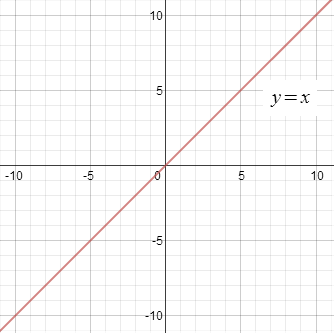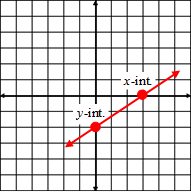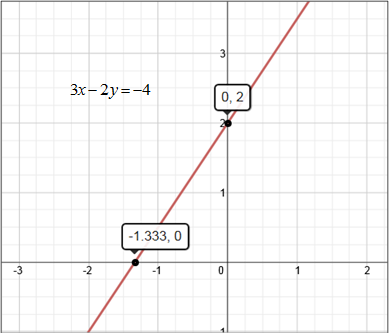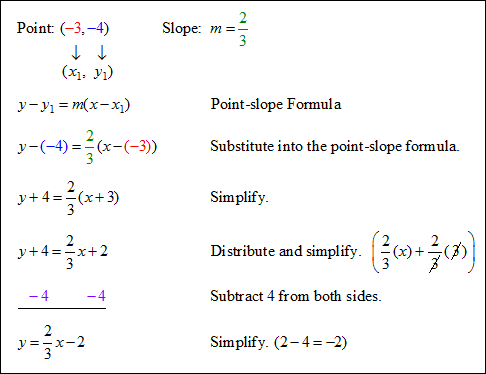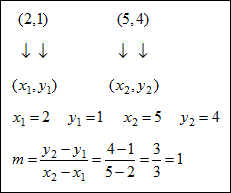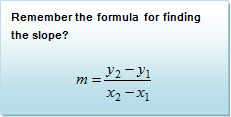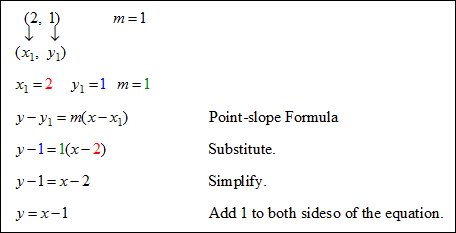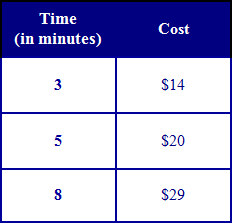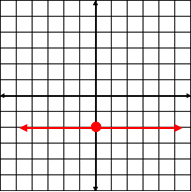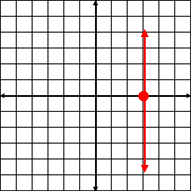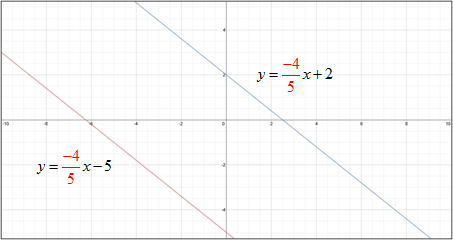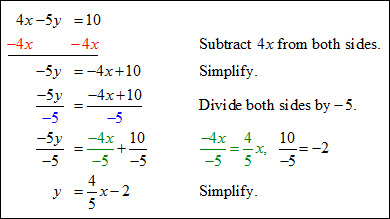LINEAR EQUATIONS AND GRAPHS
 |
Unit Overview
This unit is about linear equations and their graphs. In this unit, you will learn how to write equations of lines using the slope‑intercept form of a line and the point‑slope form. You will investigate transformations of the parent function, y = x, and learn how to graph linear equations in standard form using the x- and y-intercepts. You will take a closer look at horizontal and vertical lines. The unit will conclude with a discussion of the equations and graphs of parallel lines and perpendicular lines.
Slope-Intercept Form
One way of graphing the equation of a line is by using the slope-intercept form which identifies the slope and the y-intercept.
 |
Example #1: Identify the slope and y-intercept for the equation y =
|
To graph a line using the slope and y-intercept:
| 1) Arrange the equation into the form y = mx + b. (This means to solve the equation for y.) |
| 2) Identify the y-intercept and plot the point (0, b). |
| 3) Use the |
| 4) Draw a line through the points with a straight edge. |
Example #2: Graph –3x + 2y = –6 using the slope and y-intercept.
|
2) Plot the y-intercept, (0, –3). |
3) Use the ratio of slope |
 |
 |
|
|
4) Draw a line through the points with a straight edge.  |
|
Stop! Go to Questions #1-6 about this section, then return to continue on to the next section.
Parent Functions and Transformations
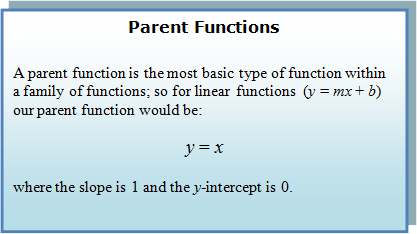 |
Transformation is when the parent function is changed by either adding, subtracting, multiplying, or dividing the original function by a constant (number).
|
Let’s explore what happens to the parent function as we change the values of m and b in the linear function y = mx + b.
Use a graphing calculator or knowledge from above to answer the below questions. Also, there is a graphing program online at https://www.desmos.com/calculator.
When comparing to the parent function, y = x, describe how each equation would alter or transform the graph.
y = x
Graph y = 3x |
![]() Describe the translation for y = 3x from the parent function y = x.
Describe the translation for y = 3x from the parent function y = x.
The steepness of the line (slope) will change from m = 1 (1/1) to m = 3 (3/1).
"Click here" to check the answer.
![]() How does the y-intercept change?
How does the y-intercept change?
The y-intercept remains 0. The graph passes through (0, 0).
"Click here" to check the answer.
![]() View the graphs.
View the graphs.

"Click here" to view both graphs.
![]() Describe the translation for y = x + 3 from the parent function y = x.
Describe the translation for y = x + 3 from the parent function y = x.
The graph is translated 3 units up and passes through the y-axis at (0, 3).
"Click here" to check the answer.
![]() How does the slope change?
How does the slope change?
The slope (m = 1) remains the same (rise / run = 1 / 1).
"Click here" to check the answer.
![]() How does the y-intercept change?
How does the y-intercept change?
The y-intercept changes from (0, 0) to (0, 3).
"Click here" to check the answer.
![]() View the graphs.
View the graphs.
![]() Describe the translation for y = –x from the parent function y = x.
Describe the translation for y = –x from the parent function y = x.
The slope of the line is now negative and goes through Quadrants II and IV.
"Click here" to check the answer.
![]() Describe one way to count out the slope (rise / run) of the graph.
Describe one way to count out the slope (rise / run) of the graph.
The rise over run is down 1, then right one.
"Click here" to check the answer.
![]() Describe a second way to count out the slope (rise / run) of the graph.
Describe a second way to count out the slope (rise / run) of the graph.
The rise over run is up 1, then left 1.
"Click here" to check the answer.
![]() How does the y-intercept change?
How does the y-intercept change?
The y-intercept remains 0. The graph passes through (0, 0).
"Click here" to check the answer.
![]() View the graphs.
View the graphs.
![]() Describe the translation for y = 2x – 5 from the parent function y = x.
Describe the translation for y = 2x – 5 from the parent function y = x.
The graph is translated 5 units down and the slope becomes steeper.
"Click here" to check the answer.
![]() How does the slope change?
How does the slope change?
The steepness of the line (slope) changes from m = 1 (1/1) to m = 2 (2/1).
"Click here" to check the answer.
![]() How does the y-intercept change?
How does the y-intercept change?
The y-intercept changes from (0, 0) to (0, –5).
"Click here" to check the answer.
![]() View the graphs.
View the graphs.

To sum it up, when the parent function was multiplied by 3, the slope (steepness of the line) was greater and when it was multiplied by –1, the slope of the line became a decreasing line instead of an increasing line, from left to right. In both instances, the y‑intercept remained the same.
Finally, in the last example, the graph was both multiplied by 2 and five was subtracted. Thus, the slope (steepness of the line) was greater, and the graph moved down 5 units.
Stop! Go to Questions #7-11 about this section, then return to continue on to the next section.
Graphing a Line Using the x- and y-intercepts
Another way to graph a line is by plotting the x- and y-intercepts. To graph using this method, it is recommended that the linear equation be expressed in standard form first.
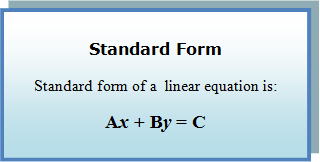 |
To find the x- and y-intercepts:
| 1) Replace x with 0 in the equation and solve for y to locate the y‑intercept (0, y). |
| 2) Replace y with 0 in the equation and solve for x to locate the x‑intercept (x, 0). |
| 3) Plot the two points and draw a straight line through them using a straight edge (ruler or something similar). |
Example #1: Graph 2x – 3y = 6 by using the x- and y-intercepts.
|
Example #2: Graph 3x = 2y – 4 by using the x- and y-intercepts.
Graph using the x- and y-intercepts:
|
Stop! Go to Questions #12-17 about this section, then return to continue on to the next section.
Point-Slope Form
When given certain information about a line, it is possible to find the equation of the line by using the point-slope form. Let's take a look at two possibilities.
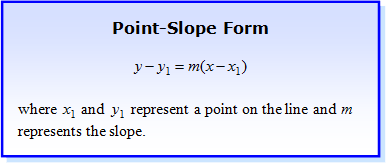 |
Given the slope and a point on the line, find the equation of the line.
Replace x1 , y1 and m with the given point and the given slope, and then solve for y.
Example #1: Write the equation of a line that contains the point (–3, –4) and has a slope of
The equation of the line passing through the point (–3, –4) with a slope of |
Given two points, find the equation of the line.
| Example #2: Write an equation of a line containing the points (2, 1) and (5, 4). Use the slope formula for finding the slope when given two points.
Replace x1 , y1 and m with the given point and the given slope, and then solve for y. We’ll use point (2, 1).
The equation of the line passing through (2, 1) and (5, 4) is y = x – 1 in slope‑intercept form. |
![]() What would the equation look like in standard form?
What would the equation look like in standard form?
–x + y = –1
"Click here" to check the answer.
![]() The equation could be transformed into an equivalent equation in simpler form by multiplying both sides by –1. What would that equation look like?
The equation could be transformed into an equivalent equation in simpler form by multiplying both sides by –1. What would that equation look like?
x – y = 1
"Click here" to view both graphs.
Now, let’s apply what we have learned to a real life situation.
Example #3: While visiting NYC, Merna created the following chart based on her cab rides. Write an equation in slope-intercept form that would represent any cab ride and then find the cost for a 7 minute cab ride using the linear equation.
Find the equation: First select ANY two ordered pairs from the chart to find the slope or rate of change:
We'll use (8, 29) for the point. We now know the slope, m = 3.
Use the equation to find the cost of a 7-minute ride in New York City.
So, a 7-minute cab ride in New York City would cost $26! |
Stop! Go to Questions #18-25 about this section, then return to continue on to the next section.
Equations of Horizontal and Vertical Lines
Let's revisit the slopes of horizontal and vertical lines and take a closer look.
| Horizontal lines have a slope of 0. |
| Vertical lines have an undefined slope or no slope. |
In this unit, we will discuss the equation of both of these lines and how to graph each.
 |
Example #1: Graph y = –2.
Notice that the line is flat. It has a slope of zero. In slope-intercept form, the equation of the line would be y = 0x –2; thus, the equation is simply, y = –2. Notice that all of the points on the line have a y-coordinate of –2; thus, y = –2. |
![]() What are the coordinates of a few points on this line?
What are the coordinates of a few points on this line?
Sample Answer: (0, –2), (–5, –2), (3, –2), (100, –2)
"Click here" to check the answer.
Example #2: Graph x = 3.
|
![]() What are the coordinates of a few points on this line?
What are the coordinates of a few points on this line?
Sample Answer: (3, 0), (3, –4), (3, 10), (3, –1000)
"Click here" to check the answer.
Stop! Go to Questions #26-30 about this section, then return to continue on to the next section.
Parallel and Perpendicular Lines
Parallel lines have the same slope.
Example #1: Are the graphs of these two linear equations parallel?
Yes, these two lines are parallel because each has a slope of The graph shows that the lines are parallel.
|
Perpendicular lines have opposite reciprocal slopes.
Example #2: Are the graphs of these two linear equations perpendicular?
Yes, the graphs are perpendicular lines because |
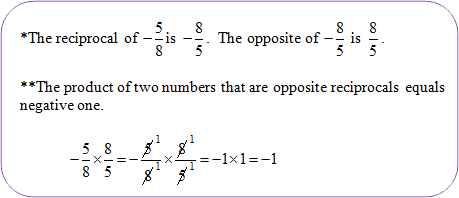 |
Let’s look at the graphs of the above lines.
Do the lines appear to be perpendicular? Do they cross at right angles?
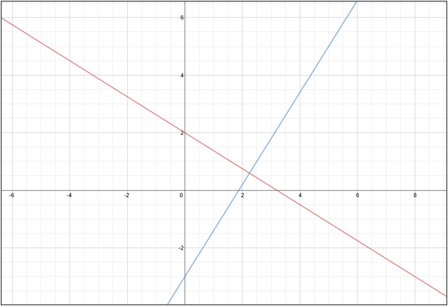 The graph appears to show that the lines are perpendicular; BUT, to be sure, we must check that the slopes are opposite reciprocals. A second check is to multiply the slopes to be sure that equal negative one. |
By knowing this, you will be able to identify and write equations of lines that are parallel to or perpendicular to given equations and containing a certain point.
| Example #3: What is the slope of a line that is parallel to 4x – 5y = 10? Arrange the equation in slope intercept form. (y = mx + b)
*Remember, parallel lines have the same slope. Now, identify the slope (m).
The graph of any linear equation with a slope of |
| Example #4: What is the slope of a line that is perpendicular to 4x – 5y = 10? *Remember, the slopes of perpendicular lines are opposite reciprocals. Examine the slope-intercept form of this equation determined in Example #3.
The graph of any linear equation with a slope of |
| Example #5: What is the equation of a line that is parallel to y = 2x + 3 and passes through the point (–1, 4)? Put the equation in slope-intercept form. Determine the slope of the given equation.
Since we want a line parallel to this line, we will use the same slope m = 2 because parallel lines have the same slope. Use the point-slope formula and substitute the slope (m = 2) and the given point (–1, 4) to determine the equation.
The equation of a line that is parallel to y = 2x + 3 and passes through the point (–1, 4) is y = 2x + 6. |
| Example #6: What is the equation of a line that is perpendicular to 5x + 2y = 10 and passes through the point (3, –5)? Put the equation in slope-intercept form. Solve the equation 5x + 2y = 10 for y and determine the slope.
The slope of this line is The opposite reciprocal of Use the point-slope formula and substitute the slope (m =
The equation of a line that is perpendicular to 5x + 2y = 10 and passes through the point (3, –5) is y = |
Now, let’s apply what we have learned to a real life situation.
Example #7: Sharon is designing a quilt using graph paper. Some of the lines need to be parallel and others need to be perpendicular. Decide which of the linear equations Sharon should select to make parallel lines and perpendicular lines for the quilt.
Put all equations into slope-intercept form by solving for y:
Answer: Sharon should use the first and last lines for the parallel section because the lines have the same slope ( |
Stop! Go to Questions #31-40 to complete this unit.

